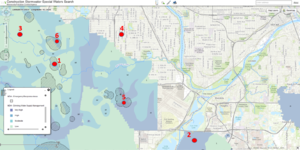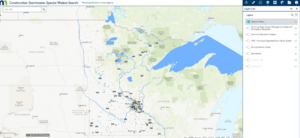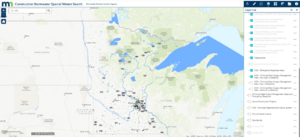
Guidance for using the Stormwater Special and impaired waters search tool
The Construction Stormwater Special and impaired waters search tool is used to find special or impaired waters near construction stormwater sites that require an NPDES stormwater permit. This page provides guidance for using the search tool to find specific conditions applicable to the permitted site.
To link to the Special and impaired waters search tool, click here.
Finding Drinking Water Source Management Areas (DWSMAs) and Emergency Response Areas (ERAs)

Infiltration of stormwater is prohibited in areas within Drinking Water Supply Management Areas (DWSMAs) having high or very high vulnerability or areas within Emergency Response Areas (ERAs). The following steps describe how to identify these features. The images on the left and right are used to illustrate these steps.
Click on any image to enlarge it.
1. Go to the Special and impaired waters search tool - click here.
2. In the upper right portion of the screen look for Map Layers. Click on the arrow next to Special Waters to expand the list of layers.
3. Scroll up or down the list of layers. Check the boxes labeled Emergency Response Area (ERA) and Drinking Water Supply (DWSMA). These are the layers of interest. Uncheck all boxes that you do not want to display. Since we are interested in ERAs and DWSMAs, you'll probably want all other boxes unchecked.
4. At this point you should have a state map with only letters from the DWSMA layer displayed. The ERA and DWSMA polygons will display once you've zoomed in to your site.
5. Zoom in to your site or use the address box to zoom in to your site. At this point you can size the map as desired to make your determination. Infiltration of stormwater is prohibited in areas within DWSMAs having high or very high vulnerability or areas within Emergency Response Areas.
The image to the right illustrates four example sites.
- Infiltration is acceptable at site 1 because, even though it overlies an Emergency Response Area (ERA), the site is located in an area with low vulnerability.
- Infiltration is prohibited at site 2, unless a higher engineering review indicates infiltration is acceptable, because it is a DWSMA with high vulnerability.
- Infiltration is acceptable at site 3 because it is not in an ERA and is in a low vulnerability DWSMA.
- Infiltration is acceptable at site 4 because it is outside an ERA and DWSMA.
- Infiltration is prohibited at site 5 because the area overlies an ERA and vulnerability is high.
- Infiltration is prohibited at site 6, unless a higher engineering review indicates infiltration is acceptable, because the site overlies an ERA in a moderate vulnerability session.
For specific requirements of the Construction Stormwater permit, link here.
This page was last edited on 8 December 2022, at 15:41.

